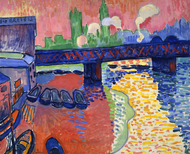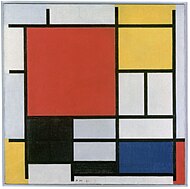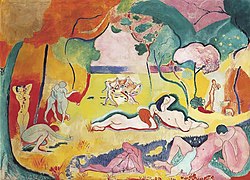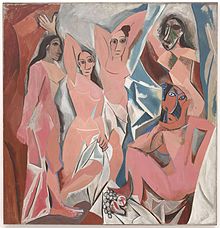History of art
Definition
Origins
Art historians disagree when Modern art began, some tracing it as far back as Francisco Goya in the Napoleonic period, the mid-19th century with the industrial revolution or the late 19th century with the advent of Impressionism. The French Revolution of 1789 gave rise to further revolutions in thought. In the arts, these included a new self-consciousness about artistic styles and individuality. Art historian H. Harvard Arnason says "a gradual metamorphosis took place in the course of a hundred years", marked by significant events such as the completion in 1784 of Jacques-Louis David's painting The Oath of the Horatii; the exhibition of Gustave Courbet's painting The Artist's Studio in 1855; and the exhibition of Édouard Manet's painting Le déjeuner sur l'herbe in the Salon des Refusés in Paris in 1863.
19th century
During the 19th century, the Romantic tendency of early modern artists such as Turner and Delacroix was succeeded by newer art movements: Realism,Impressionism, post-Impressionism, Symbolism, and other movements. Western artists were influenced by Eastern decorative arts, especially Japanese prints.
The Impressionists sought to convey movement, spontaneity, and transient effects of light in their work. Their style was adopted by artists in many countries, alongside national movements such as the Hudson River School and the Ashcan School in the US.
 Francisco de Goya, The Third of May 1808, 1814
Francisco de Goya, The Third of May 1808, 1814 Gustave Courbet, The Artist's Studio (L'Atelier du peintre): A Real Allegory of a Seven Year Phase in my Artistic and Moral Life, 1855, Musée d'Orsay, Paris
Gustave Courbet, The Artist's Studio (L'Atelier du peintre): A Real Allegory of a Seven Year Phase in my Artistic and Moral Life, 1855, Musée d'Orsay, Paris Édouard Manet, Le Déjeuner sur l'herbe, 1863, Musée d'Orsay, Paris
Édouard Manet, Le Déjeuner sur l'herbe, 1863, Musée d'Orsay, Paris Claude Monet, Impression, Sunrise(Impression, soleil levant), 1872; the painting that gave its name to the style and artistic movement, Musée Marmottan Monet (Paris)
Claude Monet, Impression, Sunrise(Impression, soleil levant), 1872; the painting that gave its name to the style and artistic movement, Musée Marmottan Monet (Paris) Georges Seurat, A Sunday Afternoon on the Island of La Grande Jatte, 1884–86, oil on canvas, 207.5 × 308.1 cm, Art Institute of Chicago
Georges Seurat, A Sunday Afternoon on the Island of La Grande Jatte, 1884–86, oil on canvas, 207.5 × 308.1 cm, Art Institute of Chicago Vincent van Gogh, Country road in Provence by Night, 1889, May 1890, Kröller-Müller Museum
Vincent van Gogh, Country road in Provence by Night, 1889, May 1890, Kröller-Müller Museum Henri Rousseau, Tiger in a Tropical Storm (Surprised!), 1891
Henri Rousseau, Tiger in a Tropical Storm (Surprised!), 1891 Henri de Toulouse-Lautrec, At the Moulin Rouge: Two Women Waltzing, 1892
Henri de Toulouse-Lautrec, At the Moulin Rouge: Two Women Waltzing, 1892 Paul Cézanne, The Large Bathers, 1898–1905
Paul Cézanne, The Large Bathers, 1898–1905- Paul Gauguin, Spirit of the Dead Watching 1892, Albright-Knox Art Gallery
 Edvard Munch, The Scream, 1893
Edvard Munch, The Scream, 1893 Alphonse Mucha, F. Champenois Imprimeur-Éditeur, 1897, lithograph
Alphonse Mucha, F. Champenois Imprimeur-Éditeur, 1897, lithograph
Early 20th century
The history of 20th-century art is a narrative of endless possibilities and the search for new standards, each being torn down in succession by the next. The art movements of Fauvism, Expressionism, Cubism, abstract art, Dadaism and Surrealism led to further explorations of new creative styles and manners of expression. Increasing globalinteraction during this time saw an equivalent influence of other cultures into Western art, such as Pablo Picasso being influenced by Iberian sculpture, African sculptureand Primitivism. Japonism, and Japanese woodcuts (which had themselves been influenced by Western Renaissance draftsmanship) had an immense influence on Impressionism and subsequent artistic developments. The influential example set by Paul Gauguin's interest in Oceanic art and the sudden popularity among the cognoscenti in early 20th century Paris of newly discovered African fetish sculptures and other works from non-European cultures were taken up by Picasso, Henri Matisse, and many of their colleagues. Later in the 20th century, Pop Art and Abstract Expressionism came to prominence.
 Henri Matisse, Woman with a Hat, 1905, San Francisco Museum of Modern Art
Henri Matisse, Woman with a Hat, 1905, San Francisco Museum of Modern Art André Derain, 1906, Charing Cross Bridge, London, National Gallery of Art, Washington, D.C.
André Derain, 1906, Charing Cross Bridge, London, National Gallery of Art, Washington, D.C. Gustav Klimt, Portrait of Adele Bloch-Bauer I, 1907, Neue Galerie New York
Gustav Klimt, Portrait of Adele Bloch-Bauer I, 1907, Neue Galerie New York Constantin Brâncuși, The Kiss, 1907–08
Constantin Brâncuși, The Kiss, 1907–08 Georges Braque, Houses at l'Estaque, 1908, Kunstmuseum Bern
Georges Braque, Houses at l'Estaque, 1908, Kunstmuseum Bern Egon Schiele, Self Portrait with Physalis, 1912, Leopold Museum
Egon Schiele, Self Portrait with Physalis, 1912, Leopold Museum Marcel Duchamp, Nude Descending a Staircase, No. 2, 1912, Philadelphia Museum of Art
Marcel Duchamp, Nude Descending a Staircase, No. 2, 1912, Philadelphia Museum of Art Robert Delaunay, 1912–13, Le Premier Disque, Private collection
Robert Delaunay, 1912–13, Le Premier Disque, Private collection Piet Mondrian, Composition with Red, Yellow, Blue, and Black, 1921, Gemeentemuseum Den Haag
Piet Mondrian, Composition with Red, Yellow, Blue, and Black, 1921, Gemeentemuseum Den Haag
Late 20th and early 21st centuries
Rapid advances in science and technology led to the late Modern and Postmodern period. In these periods, the art and cultures of the world went through many changes, and there was a great deal of intermixture between cultures, as new communications technologies facilitated the national and even global dissemination of music, art and style. The separation of regional cultures that had marked the 19th century was replaced by a global culture. Postmodernism describes a broad movement that developed in the mid- to late-20th century across philosophy, the arts, architecture, and criticism which marked a departure from modernism.
 Henry Moore, Reclining Figure, 1951, painted plaster, Fitzwilliam Museum, Cambridge
Henry Moore, Reclining Figure, 1951, painted plaster, Fitzwilliam Museum, Cambridge Yves Klein, IKB 191, 1962, monochrome painting
Yves Klein, IKB 191, 1962, monochrome painting- Joan Miró, Dona i Ocell, 1983, Parc Joan Miró, Barcelona
Text is available under the Creative Commons Attribution-ShareAlike License



